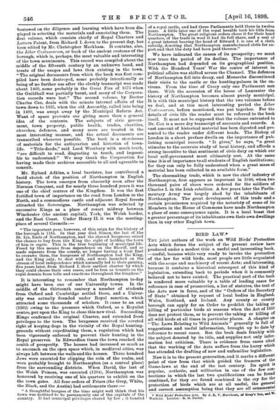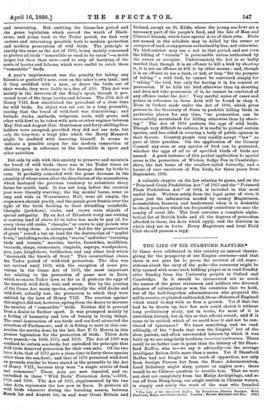BIRD LAW.*
THE joint authors of the work on Wild Birds' Protection Acts which forms the subject of the present review have produced under a modest title a useful and interesting book, —useful, because while very ready to invoke the protection of the law for wild birds, most people are little acquainted with the scope and machinery of recent Acts; and interesting, because it contains a historical retrospect of this kind of legislation, extending back to periods when it is commonly believed not to have existed. The practical part of the book is rendered more valuable by a table of leading cases for reference in case of prosecution, a list of statutes, the text of the Acts now in force, and of the " Orders of the Secretary of State" obtained by request of local bodies in England, Wales, Scotland, and Ireland. Any county or county borough can apply for an Order to prohibit the taking or killing of particular birds at seasons when the Act of 1880 does not protect them, or to prevent the taking or killing of all wild birds at all times in particular places. A chapter on " The Laws Relating to Wild Animals " generally is full of suggestions and useful information, brought up to date by reference to recent cases. But the book deals frankly with the subject denoted by its title, and supplies not only infor- mation but criticism. There is evidence from cases cited that the working of the Acts suffers from the hurry which has attended the drafting of new and unfamiliar legislation.
New it is to the present generation, and it marks a different point of view from that which guided the framers of the Game-laws at the end of the last century. Its spirit is popular, msthetic, and utilitarian in one of the few con- nections in which the last two qualifications can be found combined, for they are found combined in the cry for the protection of birds which are at all useful, the general and correct assumption being that they are all ornamental • Wad Birds' Protection Acts. By T. B., V. Marchant, of Grey's Um. and V(' Watkins. London B. H. Porter.
and interesting. But omitting the Game-law period and the game legislation which moved the wrath of Black- stone, and going back to the Tudor period, we find very curious and interesting parallels both to modern protection and modern persecution of wild birds. The principle is exactly the same as the Act of 1876, being mainly concerned to protect all birds " comestible or used to be eaten "—a much larger list then than now—and to stop all harrying of the nests of hawks and falcons, which were useful to catch these "comestible" birds.
A year's imprisonment was the penalty for taking any falcon's or goshawk's nest, even on the taker's own land ; and if they meddled with a nest, or drove the birds out of their woods, they were liable to a fine of £10. This Act was mainly in the interests of the King's sport, though it pro- tected most of the large hawks and falcons. The 25th Act of Henry VIII. first established the precedent of a close time for wild birds. Its object was set out in a long preamble, stating that the breed of wild-fowl was diminishing ; and forbade ducks, mallards, widgeons, teals, wild geese, and other wild-fowl to be taken with nets or other engines between May 31st and August 31st. Gentlemen and forty-shilling free- holders were excepted, provided they did not use nets, but only the long-bow, a huge joke which the Merry Monarch might be credited with inserting himself. It seems to indicate a possible origin for the modern connection of that weapon in reference to the incredible in sport and other activities.
But side by side with this anxiety to preserve and maintain the breed of wild birds, there was in the Tudor times an absolute panic in reference to the damage done by birds to corn. It probably coincided with the great decrease in the quantity of wheat sown after the dissolution of the monasteries, which hastened the previous tendency to substitute sheep farms for arable land. It was not long before the country poor were literally starving; the big monks' barns, some as long and wide as Westminster Hall, were all empty, the crops sown shrunk yearly, and the people grew frantic over the eight of the birds flocking to their dwindling cornfields. Choughs (jackdaws), rooks, and crows were objects of special antipathy. By an Act of Elizabeth every one owning or renting land of above £5 in value was made to pay id. for every three old rooks, " choughs," or crows to any person who should bring them. A subsequent " Act for the preservation of grain" raised a tax on land for the destruction of " noyful fowls," including rooks, Chou ghs, "stares," and other "ravening birds and vermin," martins, hawks, fursekites, moldkites, buzzards, shags, cormorants, ringtails, ospreys, woodpeckers, pies, jays, kingfishers, bullfinches, and any other bird which " devoureth the blowth of fruit." This counterblast closes the Tudor period of wild-bird protection. The idea was not revived until 1869, with the exception of some pro- visions in the Game Act of 1831, the most important Act relating to the protection of game now in force, which re-enacts Tudor laws so far as it protects the eggs of the bustard, wild duck, teal, and swan. But by the passing of the Game Act many species, especially the wild ducks and wild-fowl, actually lost the protection to which they were entitled by the laws of Henry VIII. The reaction against this neglect did not, however, spring from the desire to increase the number of " comestible " birds. Neither did it proceed from a desire to further sport. It was prompted mainly by a feeling of humanity and love of beauty in living things. The cruel destruction of sea-birds and sea-fowl attracted the attention of Parliament; and it is fitting to note in this con- nection the service done by the late Rev. F. 0. Morris in this pioneer legislation for the protection of birds. Three Acts were passed,—in 1869, 1872, and 1876. The Act of 1869 was confined to certain sea-birds, but embodied the principle that wild birds deserved protection for their own sake. Of the two later Acts, that of 1872 gave a close time to forty-three species other than the sea-fowl; and that of 1876 protected wild-fowl on grounds similar to those stated in the preamble to the Act of Henry VIII., because they were "a staple article of food and commerce." These Acts are now repealed, and re- embodied in three " Wild Birds' Protection Acts,"-1881, 1894, and 1896. The Act of 1881, supplemented by the two later Acts, represents the law now in force. It protects all wild birds whatever during the breeding season, between March let and August 1st, in and near Great Britain and Ireland, except on St. Kilda, where the young sea-fowl are a necessary part of the people's food, and the Isle of Man and Channel Islands, which have special Acts of their own. Birds, not named in the schedule may be killed by the owner or occupier of land, or any person authorised by him; not otherwise. No bird-catcher may use a net in that period, and not even the killing of " vermin " is permissible unless authorised by the owner or occupier. Unfortunately the Act is so badly worded that, though it is an offence to kill a bird by shooting, it, it is not an offence to kill it by other means ; and, though it is an offence to use a boat, or net, or trap " for the purpose of taking " a wild bird, he cannot be convicted simply for " taking " the bird, but only for having it in his control or possession. If he kills the bird otherwise than by shooting and does not take possession of it, he cannot be convicted of any offence under the Act ! Very careful notes of cases and points in reference to these Acts will be found in chap. 4. Even in Orders made under the Act of 1896, which gives, powers to the Secretary of State to prohibit killing birds in particular places for any time, " no prosecution can be successfully maintained for killing otherwise than by shoot- ing." The Act of 1894 protects the eggs of wild birds. Though very difficult to enforce, it is useful to protect certain species, and has aided in creating a body of public opinion in their favour. Country people very readily accept "law" as- part of their practice. On the application of the County Council any area or any species of bird can be protected,, whether the eggs of all or of specified kinds of birds are named. A good instance of this partial application to special areas is the protection of Wicken Sedge Fen in Cambridge- shire, the last home of the swallow-tailed butterfly, and a haunt of rare survivors of Fen birds, for three years from September, 1895.
A valuable chapter on the law relating to game, and on the " Poisoned Grain Prohibition Act " of 1863 and the " Poisoned Flesh Prohibition Act" of 1864, is included in this most useful book. Written solely from the legal point of view, it gives just the information needed by county Magistrates, householders, farmers, and landowners when it is desirable to check practices which too frequently contribute to mar the comity of rural life. The book contains a complete alpha- betical list of British birds and all the degrees of protection afforded to them, the Acts which apply, and the districts in which they are in force. Every Magistrate and local Field Club should possess a copy.



































 Previous page
Previous page